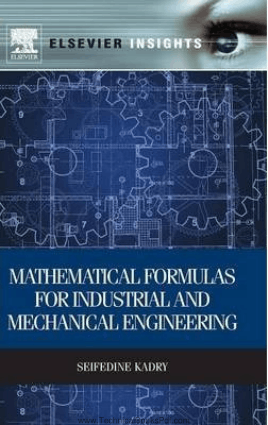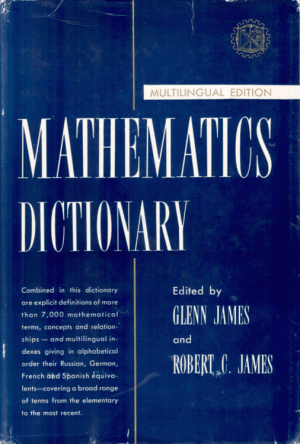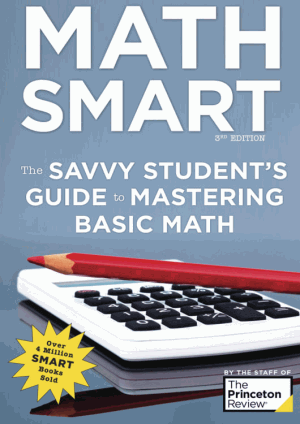Mathematical Formulas for Industrial and Mechanical Engineering

| Mathematics Books | |
| Language | English |
| File Type | |
| 133 | |
| Views | 2,828 views |
| File Size & Downloads | Size 1.7 MiB Downloads 839 |
Short Desciption:
This "Mathematical Formulas for Industrial and Mechanical Engineering" book is available in PDF Formate. Downlod free this book, Learn from this free book and enhance your skills ...
Description
Mathematical Formulas For Industrial and Mechanical Engineering serves the needs of students and teachers as well as professional workers in engineering who use mathematics. The contents and size make it especially convenient and portable. The widespread availability and low price of scientific calculators have greatly reduced the need for many numerical tables that make most handbooks bulky. However, most calculators do not give integrals, derivatives, series and other mathematical formulas and figures that are often needed. Accordingly, this book contains that information in an easy way to access in addition to illustrative examples that make formulas clearer. Students and professionals alike will find this book a valuable supplement to standard textbooks, a source for review, and a handy reference for many years.
Table of Contents
- Preface
- Biography
- 1. Symbols and Special Numbers
- 1.1 Basic Mathematical Symbols
- 1.2 Basic Algebra Symbols
- 1.3 Linear Algebra Symbol
- 1.4 Probability and Statistics Symbols
- 1.5 Geometry Symbols
- 1.6 Set Theory Symbols
- 1.7 Logic Symbols
- 1.8 Calculus Symbols
- 1.9 Numeral Symbols
- 1.10 Greek Alphabet Letters
- 1.11 Roman Numerals
- 1.12 Prime Numbers
- 1.13 Important Numbers in Science (Physical Constants)
- 1.14 Basic Conversion Formulas
- 1.15 Basic Area Formulas
- 1.16 Basic Perimeter Formulas
- 1.17 Basic Volume Formulas
- 2. Elementary Algebra
- 2.1 Sets of Numbers
- 2.2 Fundamental Properties of Numbers
- 2.3 Absolute Value
- 2.4 Basic Properties of Real Numbers
- 2.5 Laws of Exponents
- 2.6 Logarithm
- 2.7 Factorials
- 2.8 Factors and Expansions
- 2.9 Solving Algebraic Equations
- 2.10 Intervals
- 2.11 Complex Numbers
- 2.12 The Complex Plane
- 2.13 Complex Numbers in Polar Form
- 2.14 Multiplication and Division in Polar Form
- 2.15 DeMoivre’s Theorem
- 2.16 Euler’s Formula
- 3. Linear Algebra
- 3.1 Basic Definitions
- 3.2 Basic Types of Matrices
- 3.3 Basic Operations on Matrices
- 3.4 Properties of Matrix Operations
- 3.5 Determinants
- 3.6 Sarrus Rule
- 3.7 Minors and Cofactors
- 3.8 Properties of Determinants
- 3.9 Inverse Matrix
- 3.10 System of Linear Equations
- 3.11 Methods of Solution
- 3.12 Inverse Matrix Method
- 3.13 Determinant Method (Cramer’s Rule)
- 4. Analytic Geometry and Trigonometry
- 4.1 Plane Figures—Perimeter (P), Circumference (C), and Area (A)
- 4.2 Solid Figures—Surface Area (S) and Volume (V)
- 4.3 Right Triangle
- 4.4 Any Triangle
- 4.5 Degrees or Radians
- 4.6 Table of Natural Trigonometric Functions
- 4.7 Trigonometry Identities
- 4.8 The Inverse Trigonometric Functions
- 4.9 Solutions of Trigonometric Equations
- 4.10 Analytic Geometry (in the plane, i.e., 2D)
- 4.11 Vector
- 5. Calculus
- 5.1 Functions and Their Graphs
- 5.2 Limits of Functions
- 5.3 Definition and Properties of the Derivative
- 5.4 Table of Derivatives
- 5.5 Higher Order Derivatives
- 5.6 Applications of Derivative
- 5.7 Indefinite Integral
- 5.8 Integrals of Rational Function
- 5.9 Integrals of Irrational Function
- 5.10 Integrals of Trigonometric Functions
- 5.11 Integrals of Hyperbolic Functions
- 5.12 Integrals of Exponential and Logarithmic Functions
- 5.13 Reduction Formulas Using Integration by Part
- 5.14 Definite Integral
- 5.15 Improper Integral
- 5.16 Continuity of a Function
- 5.17 Functions and Graphs
- 5.18 Partial Fractions
- 5.19 Properties of Trigonometric Functions
- 5.20 Sequences and Series
- 5.21 Arithmetic Sequences and Series
- 5.22 Geometric Sequences and Series
- 5.23 The Finite Geometric Series
- 5.24 The Infinite Geometric Series
- 5.25 Some of Finite and Infinite Series
- 5.26 Convergence Tests for Series
- 5.27 Series Tests
- 5.28 Integral Test
- 5.29 Comparison Tests
- 5.30 Ratio Test
- 5.31 Absolute and Conditional Convergence
- 5.32 Taylor and Maclaurin Series
- 5.33 Continuous Fourier Series
- 5.34 Double Integrals
- 5.35 Triple Integrals
- 5.36 First-Order Differential Equations
- 5.37 Second-Order Differential Equations
- 5.38 Laplace Transform
- 5.39 Table of Laplace Transforms
- 6. Statistics and Probability
- 6.1 Arithmetic Mean
- 6.2 Median
- 6.3 Mode
- 6.4 Geometric Mean
- 6.5 Standard Deviation
- 6.6 Variance
- 6.7 z-Score
- 6.8 Coefficient of Variation
- 6.9 Sample Covariance
- 6.10 Range
- 6.11 Central Limit Theorem
- 6.12 Counting Rule for Combinations
- 6.13 Counting Rule for Permutations
- 6.14 Properties of Probability
- 6.15 Binomial Probability Function
- 6.16 Expected Value and Variance for the Binomial Distribution
- 6.17 Poisson Probability Function
- 6.18 Confidence Intervals
- 6.19 Sample Size
- 6.20 Regression and Correlation
- 6.21 Pearson Product–Moment Correlation Coefficient
- 6.22 Test Statistic for Hypothesis Tests about a Population Proportion
- 6.23 Chi-Square Goodness-of-Fit Test Statistic
- 6.24 Standard Normal Distribution Table
- 6.25 Table of the Student’s t-distribution
- 6.26 Chi-square Table
- 6.27 Table of F-statistics, P=0.05
- 7. Financial Mathematics
- 7.1 Percentage
- 7.2 The Number of Payments
- 7.3 Convert Interest Rate Compounding Bases
- 7.4 Effective Interest Rate
- 7.5 The Future Value of a Single Sum
- 7.6 The Future Value with Compounding
- 7.7 The Future Value of a Cash Flow Series
- 7.8 The Future Value of an Annuity
- 7.9 The Future Value of an Annuity Due
- 7.10 The Future Value of an Annuity with Compounding
- 7.11 Monthly Payment
- 7.12 The Present Value of a Single Sum
- 7.13 The Present Value with Compounding
- 7.14 The Present Value of a Cash Flow Series
- 7.15 The Present Value of an Annuity with Continuous Compounding
- 7.16 The Present Value of a Growing Annuity with Continuous Compounding
- 7.17 The Net Present Value of a Cash Flow Series
- 7.18 Expanded Net Present Value Formula
- 7.19 The Present Worth Cost of a Cash Flow Series
- 7.20 The Present Worth Revenue of a Cash Flow Series


